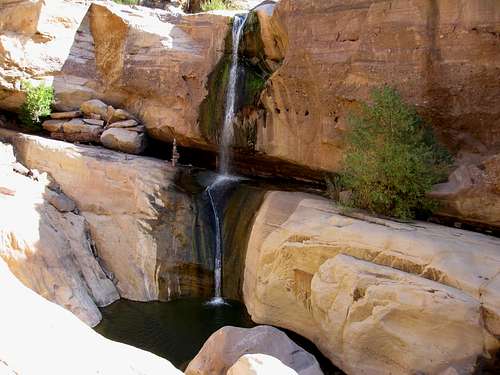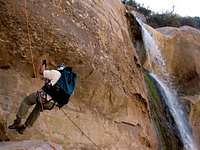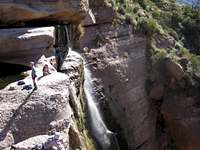![Rappel in Tar Creek]() Upper Tar Creek Falls, our first rappel
Upper Tar Creek Falls, our first rappel
I had been intending to lead a “first time canyoneering” outing for the California Mountaineering Club when the so-called “Station” fire in the Angeles National Forest of southern California came along and put off- limits virtually all the canyons in the San Gabriel front range. I asked an avid canyoneer friend, Ron Hudson, for suggestions on a canyon suitable for first time canyoneers and also asked him if he would co-lead a trip with me. Ron suggested Tar Creek in the Sespe Wilderness in Ventura County, a canyon he had done before.
Five CMC members showed up in Fillmore at 7 a.m. on a fine Sunday morning to join Ron and me. Fairly typical of many first time canyoneers, all had climbing experience but most had never done a canyon before. We carpooled to the Tar Creek trailhead and took off on a trail toward Tar Creek. The two mile approach was relatively easy. There was no bush-whacking involved although we did encounter a couple of very steep descents dropping into the creek.
![Canyoneering in Tar Creek]() Kathy and Karla near Tar Creek
Kathy and Karla near Tar CreekCascades and Rock Pools
![Waterfalls in Tar Creek]() Tar Creek Cascades
Tar Creek Cascades
Once in the creek bottom, it wasn’t long before we came to the first rappel opportunity. Called the Tar Creek Cascades, it consisted of a magnificent 3-terrace waterfall with considerable flow tumbling into polished rock pools below. Because a rappel here would have involved dropping into frigid water and we did not have wetsuits, we opted to downclimb to the right of these falls.
![Rock Pools in Tar Creek]() Rock pool
Rock poolFirst Rap
We got to our first rappel at Upper Tar Creek Falls. Here, a waterfall plunges into a deep pool at the bottom of a huge ravine. We would rappel to the right of the waterfall and only the 40 feet to a ledge half-way down so as to avoid dropping into the pool at the bottom.
![Rock Art in Tar Creek]() Rock art in Tar Creek
Rock art in Tar Creek![Moving Down Tar Creek]() Moving down the polished rock
Moving down the polished rock
While everyone geared up, Ron and I briefly went over some of the unique aspects of canyoneering. In particular, we focused on the manner in which canyoneering rappels differ from those typically done by climbers. We went over different rappel devices used by canyoneers, techniques for adjusting friction in mid-rappel, and making sure everyone knew at least one method for locking off in mid-rappel.
For our anchor, we located a solid boulder about 25 feet back from the edge of the rappel and constructed a “choke” anchor with a single strand of webbing coming out to the edge of the drop. We blocked one side of my 60m x 9.2mm canyoneering rope and went down single strand.
One nice thing about this canyon is that there has been no need to install bolts for the rappels. The natural anchors are there and hopefully no one in the future will place bolts merely for convenience.
I went down first and Ron supervised things on top. Everyone had fun warming up on this easy drop. After pulling the rope, we traversed to a rock plateau and had a short break to snack and catch the sun’s rays. Then, on to the Big Drop.
![Rappel in Tar Creek]() Tom R. on first rappel
Tom R. on first rappel![Rappel in Tar Creek]() Gerard L. going down first drop
Gerard L. going down first dropLower Tar Creek Falls: The Big One
Our second rappel would be 165-170 feet. The drop was next to a humongous waterfall to our left. We found a suitable rock about 10 feet back from the edge to use as an anchor. This time we tied two ropes together for our rappel.
![170 Rap in Tar Creek]() 170' Lower Tar Creek Falls
170' Lower Tar Creek Falls
Because we could not see the bottom of the drop and thus couldn’t tell if the rope reached the bottom, I set up a releasable system using a Figure 8 device so that I could be lowered in case the rope was short.
The start presented a little bit of a challenge because the first steps off the edge were on an overhang. About 30 feet down I noticed that a section of the rope below me was in a huge tangle. This wasn’t too surprising since the strand we were rappelling on was a brand new 9mm rope and was pretty stiff. I locked off and set to work to untangle the rope. The tangle wasn’t as bad as it looked and I soon had the problem fixed.
About 120 feet down, I was finally able to see the end of the rope. It hadn’t reached the bottom; rather, about 50 feet of it had landed on a small ledge about 30 feet from the bottom. When I reached the ledge I picked up and tossed the rope to the deck.
The highlight of this rappel was a free-hanging section about 2/3’s of the way down. A fireman’s belay was provided for everyone except me of course as the first one down. I used an auto-block for safety. Given the length of the drop, everyone got to experience the decreasing friction as you get nearer the bottom and thus the need to be able to adjust your friction mid-rappel.
Down to the Sespe and Return
After this second and last drop, we headed further down the canyon toward the major waterway that is Sespe Creek. Some of us went all the way to the junction where Tar Creek meets the Sespe. We then gathered to head back to the trailhead. We opted to scramble back up canyon the way we had come, being able to by-pass the places where we had rappelled. Some of the climb back up canyon involved 4th class moves. We were able to take back all the gear used in constructing our anchors so we left the canyon clean.
![View of Frst Rappel in Tar Creek]() Upper Tar Creek Falls seen on the return
Upper Tar Creek Falls seen on the return
Darkness caught us the last half hour of our return but we were able to get by without breaking out the headlamps. The outing had taken us a little over 9 hours.
It was a great day with only one thing missing. We had been in an area which serves as habitat for the rarely seen California Condor. They were able to remain rarely seen, at least by us.












Comments
Post a Comment